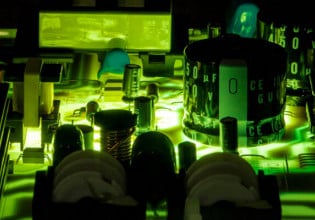USCAR And U.S. DOE To Invest Up to $195 Million in Materials and Batteries Research
Ford Motor Company (Detroit), General Motors Corporation (Detroit) and DaimlerChrysler Corporation (Auburn Hills, MI), as members of the United States Council for Automotive Research (USCAR), today signed cooperative research agreements with the U.S. Department of Energy (DOE) to support continued research and development in the areas of lightweight materials and advanced battery technologies for vehicles.
The agreements, which include DOE funding and industry cost share, represent a total investment potential of $195 million over the next five years. Nearly all of the DOE funding will be passed via subcontracts to suppliers and research institutions through the U.S. Advanced Battery Consortium (USABC) and U.S. Automotive Materials Partnership (USAMP), both consortia of the USCAR.
Today's $125 million USABC agreement is set for three years with two, one-year continuing options in which the government and industry will share the costs of research. Combined with a $70 million USAMP agreement for lightweight, high-strength materials research, which was initially announced in May, the total joint investment potential in vehicle technologies is $195 million over the next five years.
As part of the USABC agreement, the Department of Energy's (DOE) FreedomCAR Program will split the cost of research and development for a number of new battery materials and technologies that have the potential to increase energy storage and charge/discharge performance, improve durability and reliability and reduce cost.
The DOE/USCAR partnership has been ongoing for more than 10 years. One of its major accomplishments has been the development of the nickel metal hydride (NiMH) battery technology used in current, commercially available, light-duty hybrid electric vehicles. In addition, USABC is pursuing the development of advanced lithium ion systems. This emerging technology offers the promise of compact, longer-life, high-power and high-energy batteries for electric, hybrid-electric vehicles and fuel cell vehicles.
Similarly, DOE's FreedomCAR Program and USAMP will split the cost of research and development for a number of new materials and technologies that will reduce weight without compromising durability, reliability, and safety of vehicles.
Improved manufacturing and use of advanced high-strength steel can reduce vehicle weight by 15 to 25 percent. The research will also work to develop new alloys of aluminum, magnesium and titanium to be used in vehicle framing, body, powertrain and engine components. Beyond metals, new materials for use in car manufacturing such as carbon fiber and polymer matrix composites could produce weight reductions from 25 and up to 70 percent.
Each of the automakers noted the benefits of their collaborative work through USCAR and its consortia, citing applications of technologies that already have made their way into specific vehicles:
DaimlerChrysler has made great strides in advanced material research with the creation of the ME 412. An all aluminum engine, carbon fiber/aluminum body, and carbon ceramic composite disc brake rotors make up a vehicle that is on the cutting edge of technology. By utilizing what has been learned from the ME 412, many of these technological advances in materials were further developed in the new Jeep Hurricane concept vehicle.
DaimlerChrysler has a dedicated battery development division where engineers work to make improvements in nickel metal hydrid and lithium ion batteries that not only benefit the fuel cell program but the development of an advanced two-mode hybrid system that DaimlerChrysler is currently developing with GM.
Ford, showcasing its newly launched, Mercury Mariner Hybrid, cited USABC development and benchmarking programs that provided a comprehensive understanding of the best available hybrid electric vehicle technology. Ford also credited USAMP's Automotive Composite Consortium for developing a process that enabled the development of lightweight composite body sides in the Aston Martin product line and cited high-strength steel technologies that are funneling into its 2008 and 2009 programs.
General Motors' partnership with USCAR and the Department of Energy has resulted in significant achievements in areas including advanced propulsion, hybrids and fuel cells — all aimed at reducing fuel consumption and as a consequence reliance on imported oil. GM's Sequel exemplifies the company's drive to reinvent the automobile and remove it from the environmental equation. The Sequel, built on an 11-inch chassis with an all-aluminum frame, combines fuel cells, by-wire and wheel hub motors to create an a vehicle that travels 300 miles on its hydrogen supply.
Light-weight materials, the focus of USAMP, also are important to the reduction of fuel consumption. GM showcased the new Corvette Z06 with a magnesium engine cradle that is 35 percent lighter than its aluminum counterpart.
"Bringing together the best minds in industry, government and academia will develop technology faster and more cost effectively than any one organization could do alone," USCAR Executive Director Bill Gouse said.






